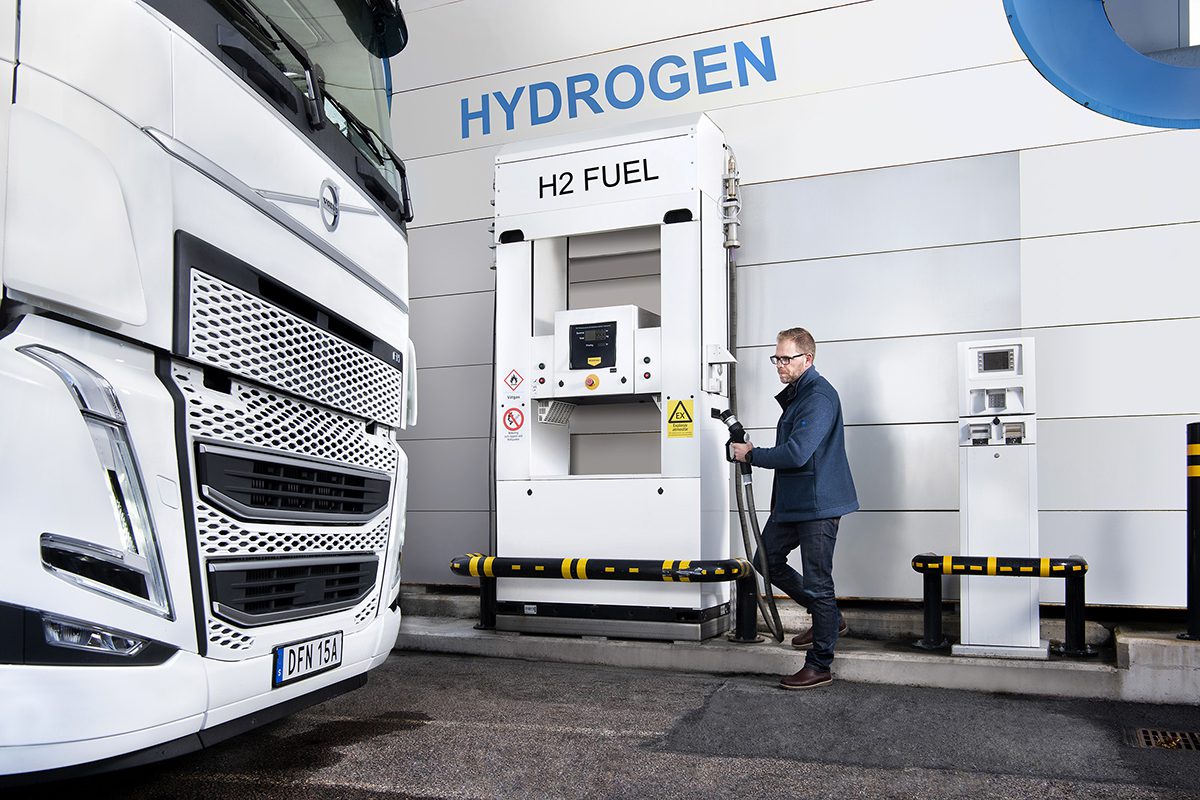In the quest for a more sustainable future, the global transportation industry finds itself at a critical crossroads. With climate change looming large, the need to reduce greenhouse gas emissions and transition to low- and zero-emission technologies has never been more pressing. Volvo Trucks, a veteran in the clean transportation industry, is at the forefront of the movement for decarbonization through a strategic three-pillar approach: battery-electric trucks, hydrogen fuel cell electric trucks, and drop-in fossil-free fuels, including fueling internal combustion engines (ICE) with hydrogen. While there are important opportunities created by harnessing the power of hydrogen, Volvo believes that a combination of these three strategies will enable the company to achieve its sustainability goal of reaching 100% net zero emissions and be fossil free by 2040.
In the mid-20th century, heavy-duty diesel ICEs revolutionized how the world transports goods. Rapid market adoption was spurred by the fact that diesel ICEs offer long driving ranges while providing efficient, cost-effective operation and high power. These attributes have enabled the diesel ICE to become the dominant commercial engine for nearly a century, and heavy-duty sectors of the economy will undoubtedly continue to rely on the internal combustion engine for years to come. With both the public and private sectors increasingly focused on improving economic and environmental sustainability, the revolution is now in high gear to develop and commercially deploy ultra-clean heavy-duty modes of transportation.
Volvo Trucks is exploring two innovative methods to harness the power of hydrogen: one involves the utilization of fuel cells that generate their own electricity from the hydrogen onboard to power an electric engine instead of being charged from an external source; while the other explores the potential of hydrogen injected into internal combustion engines. These dual approaches showcase Volvo’s commitment to offering versatile and sustainable solutions to meet the evolving demands of the transportation sector.
The hydrogen ICE has been around just as long as the hydrogen fuel cell engine. But hydrogen fuel cell technology offers the advantage of an electric drive system, which gives it the edge on efficiency, reduced local emissions, and longer range. On the other hand, a hydrogen ICE doesn’t require the dual incremental cost of the electric drive and fuel cell system.
Rapidly transitioning away from diesel to carbon-free hydrogen as the dominant heavy-duty ICE fuel can serve two key needs: 1) it can help ensure that “legacy” heavy-duty freight vehicles are ultra clean, significantly reducing emissions compared to traditional fossil fuels for as long as ICE technology continues in the market; and 2) it can help provide much-needed market demand that can incentivize hydrogen producers to rapidly develop fueling stations.
“Many segments will continue to use internal combustion engines but that doesn’t mean those will be the combustion engines that we use today,” according to Jessica Sandstrom, head of product management for Volvo Trucks. “We continue to work to make the combustion engine more efficient to have the capability of running on different fuels. It could be bioenergy or hydrotreated vegetable oil, but it could be also hydrogen in a combustion engine. So, we are working on all of these in parallel because that is the challenge, the potential, and the beauty of the transformation that we are in.”
Key to that potential is the production of “green” hydrogen, which is produced using renewable energy sources, such as wind, water, and sun, to create a fully carbon-neutral hydrogen production process. Green hydrogen accounts for a very small percentage of the total hydrogen production today, but Volvo expects that supply to increase significantly during the next several years. Global initiatives to support the production of carbon-neutral hydrogen like the European Commission’s hydrogen strategy for a climate-neutral Europe and the U.S. National Clean Hydrogen Strategy and Roadmap are the first steps in accelerating its production. The U.S. government also recently announced $7 billion in federal funding for regional clean hydrogen hubs as part of the Bipartisan Infrastructure Law to accelerate the domestic market for low-cost, clean hydrogen.
Hydrogen has long been touted as a game-changer in the effort to decarbonize the transportation sector. When hydrogen is used in a fuel cell engine, the only emission is water vapor. When hydrogen is burned as the fuel for an ICE using optimized combustion technology, the result can be extremely low emissions of smog-forming pollutants and zero direct emissions of greenhouse gases. Notably, such an advanced hydrogen ICE can achieve these strong environmental benefits at a lower capital cost than the zero-emission fuel cell counterpart. Volvo recognizes the value of both approaches to the transportation revolution and is taking bold steps to leverage hydrogen in both types of its next-generation heavy-duty trucks.
Fleets that are currently deploying diesel trucks will understand the mechanics of the ICE hydrogen engine because it is a similar technology to diesel engines. But with a lower cost than hydrogen fuel cell vehicles, this option can provide fleets with a practical, sustainable solution utilizing technology that has proven itself for decades. It also offers a versatile solution that can meet the needs of diverse applications, including heavy-duty, long-haul trucking, where the use of battery-electric trucks is limited due to range limitations, unpredictable routes, and lack of charging infrastructure.
Volvo Trucks is setting a powerful example for the transportation industry, showcasing how innovation, sustainability, and decarbonization go hand in hand. By embracing hydrogen fuel cells while also exploring hydrogen in ICEs, the company is providing practical solutions for the present while paving the way for a cleaner, greener future. Manufacturers can continue to leverage their investments in ICE vehicle drivetrain design, supply chain, and manufacturing by continuing to plan around low-carbon hydrogen internal combustion engines. Similarly, hydrogen fuel producers and suppliers get the best of both worlds in the building out of demand for their product. This economy of scale will reduce the costs of producing green hydrogen and enable progressively larger volumes to be sold in the marketplace.



